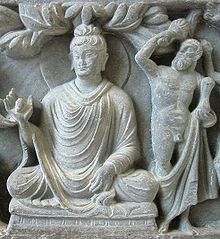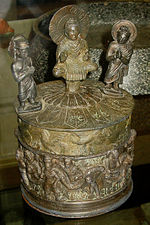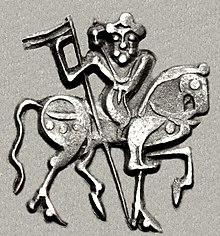Khyber Pakhtunkhwa
[6][7] Once a stronghold of Buddhism, Khyber Pakhtunkhwa is the site of the ancient region of Gandhara, including the ruins of the Gandharan capital of Pushkalavati (located near present day Charsadda).[9] The Provincial Assembly of Khyber Pakhtunkhwa subsequently approved the bill on 28 May 2018;[10] it was signed into law on 31 May by erstwhile Pakistani president Mamnoon Hussain, which officially completed the administrative merger process.The need for a change was explained by the man who named Pakistan in his "Now or Never" pamphlet, Choudhary Rahmat Ali Khan, as: "North-West Frontier Province" is semantically non-descript and socially wrongful.[22] In early 2010, the process of renaming proceeded and the Pakistani Senate confirmed the name change to Khyber Pakhtunkhwa in the 18th amendment to the Constitution of Pakistan with a unanimous 90 votes on 15 April 2010.[55][56] The region of Gandhara, which was primarily based in the area of modern-day Khyber Pakhtunkhwa features prominently in the Rigveda (c. 1500 – c. 1200 BCE),[57][48] as well as the Zoroastrian Avesta, which mentions it as Vaēkərəta, the sixth most beautiful place on earth created by Ahura Mazda.However, it was Chandragupta's grandson Ashoka, who converted to Buddhism and made it the official state religion in Gandhara and also Pakhli, the modern Hazara, as evidenced by rock-inscriptions at Shahbazgarhi and Mansehra.Around 125 BCE, the Greco-Bactrian king Heliocles, son of Eucratides, fled from the Yuezhi invasion of Bactria and relocated to Gandhara, pushing the Indo-Greeks east of the Jhelum River.For most of their history, the leading Gondopharid kings held Taxila (in the present Punjab province of Pakistan) as their residence, but during their last few years of existence the capital shifted between Kabul and Peshawar.His immediate successors were the fabled Hindu kings: Kanishka, Huvishka, and Vasushka or Vasudeva, of whom the first reigned over a territory which extended as far east as Benares, far south as Malwa, and also including Bactria and the Kabul valley.At the close of the fourteenth century they were firmly established in their present-day demographics south of Kohat, and in 1451 Bahlol Lodi's accession to the throne of Delhi gave them a dominant position in Northern India.[81] Under the reign of Babar's son, Humayun, a direct Mughal rule was briefly challenged with the rise of the Pashtun Emperor, Sher Shah Suri, who began construction of the famous Grand Trunk Road – which links Kabul, Afghanistan with Chittagong, Bangladesh over 2000 miles to the east.[84] Following another massacre in the winter of 1673, Mughal armies led by Emperor Aurangzeb himself regained control of the entire area in 1674,[82] and enticed tribal leaders with various awards in order to end the rebellion.[88] In 1749, the Mughal ruler was induced to cede Sindh, the Punjab region and the important trans Indus River to Ahmad Shah in order to save his capital from the Durrani attack.In 1757, he captured Delhi and sacked Mathura,[90] but permitted the Mughal dynasty to remain in nominal control of the city as long as the ruler acknowledged Ahmad Shah's suzerainty over Punjab, Sindh, and Kashmir.The city's famous Mahabat Khan, built in 1630 in the Jeweller's Bazaar, was badly damaged and desecrated by the Sikhs, who also rebuilt the Bala Hissar fort during their occupation of Peshawar.British campaigns to subdue tribesmen along the Durand Line, as well as three Anglo-Afghan wars, made travel between Afghanistan and the densely populated heartlands of Khyber Pakhtunkhwa increasingly difficult.Other projects, such as the Attock Bridge, Islamia College University, Khyber Railway, and establishment of cantonments in Peshawar, Kohat, Mardan, and Nowshera further cemented British rule in the region.Afghanistan's refusal to recognize the Durrand Line, and its subsequent support for the Pashtunistan Movement has been cited as the main cause of tensions between the two countries that have existed since Pakistan's independence.The province has been reported to struggle with the issues of crumbling schools, non-existent healthcare, and lack of any sound infrastructure while areas such as Islamabad and Rawalpindi receive priority funding.[119] Khyber Pakhtunkhwa sits primarily on the Iranian plateau and comprises the junction where the slopes of the Hindu Kush mountains on the Eurasian Plate give way to the Indus-watered hills approaching South Asia.[120] The famous Khyber Pass links the province to Afghanistan, while the Kohalla Bridge in Circle Bakote Abbottabad is a major crossing point over the Jhelum River in the east.[122] The major rivers that criss-cross the province are Kabul, Swat, Chitral, Kunar, Siran, Panjkora, Bara, Kurram, Dor, Haroo, Gomal, and Zhob.[125] On the southern flanks of Nanga Parbat and in Upper and Lower Dir Districts, rainfall is much heavier than further north because moist winds from the Arabian Sea are able to penetrate the region.[129] Since cold air from the Siberian High loses its chilling capacity upon crossing the vast Karakoram and Himalaya ranges, winters in central Khyber Pakhtunkhwa are somewhat milder than in Chitral.As in central Khyber Pakhtunkhwa, the seasonality of precipitation shows a very sharp gradient from west to east, but the whole region very rarely receives significant monsoon rainfall.[149] The overwhelming majority of the residents of the Khyber Pakhtunkhwa follows and professes the Sunni Islam while there is a significant amount of shia Muslims in areas such as Kurram, Kohat, Hangu, Orakzai, Dera Ismail khan, Mardan, and many other districts throughout central-southern kpk.[152] The tribe of Kalasha in southern Chitral still retain an ancient form of Polytheism mixed with Animism, a faith once dominant in the mountainous upper northeast of the district.The American involvement in neighbouring Afghanistan contributed towards the electoral victory of the Islamic coalition led by Jamaat-e-Islami Pakistan (JeI) whose social policies made the province a ground-swell of anti-Americanism.[163] Policy enforcement of a range of social restrictions, though the implementation of strict Shariah was introduced by the Muttahida Majlis-e-Amal government the law was never fully enacted due to objections of the Governor of Khyber Pakhtunkhwa backed by the Musharraff administration.[176] Agriculture remains important and the main cash crops include wheat, maize, tobacco (in Swabi), rice, sugar beets, as well as fruits are grown in the province.











From the top-right:
Light green: Hazara division
Red: Malakand division
Teal: Mardan division
Orange: Peshawar division
Pink: Kohat division
Brown: Bannu division
Blue: Dera Ismail Khan division



PashtoProvinceSwat RiverBab-e-KhyberMahabat Khan MosqueKalam ValleyBahrainLake Saiful MulukKaghan ValleyPakistanAccession to PakistanMerged into West PakistanRestorationName ChangedFATA MergerPeshawarBannu DivisionDera Ismail Khan DivisionHazara DivisionKohat DivisionMalakand DivisionMardan DivisionPeshawar DivisionSelf-governing provincefederal governmentGovernment of Khyber PakhtunkhwaGovernorFaisal Karim KundiChief MinisterAli Amin GandapurChief SecretaryProvincial AssemblyHigh CourtPeshawar High Court2023 censusTotal (2022)Time zoneArea codeISO 3166 codeEnglishPeshawar ZalmiPeshawar PanthersKhyber Pakhtunkhwa cricket teamLiteracy rateSeats in National AssemblySeats in Provincial AssemblyDivisionsDistrictsTehsilsUnion councilsNorth West Frontier Provincenorthwestern regionBalochistanPunjabIslamabad Capital TerritoryAzad KashmirGilgit-Baltistaninternational borderAfghanistanmountain rangesits economyPakistan's total populationPashtunsHindkowansSaraikisChitralisstronghold of BuddhismGandharaPushkalavatiCharsaddaKhyber PassNorth-West Frontier Province18th Constitutional AmendmentNational Assembly of Pakistan25th Constitutional AmendmentProvincially Administered Tribal AreasProvincial Assembly of Khyber PakhtunkhwaMamnoon HussainKhyberLand of the PashtunsBritish Indian EmpireAwami National PartyPunjabi peopleSindhi peopleBaloch peoplePashtun peoplePakistan Muslim League (N)Pakistan Peoples PartyHazarewalsHazara regionHindkoBritish RajMuslim LeagueNow or NeverChoudhary Rahmat AliMuhammad Zia-ul-HaqKhan Abdul Ghaffar KhanNawaz SharifMuslim League NawazHazaraAsif ZardariPashtun nationalistPakistani Senate18th amendmentConstitution of PakistanAbbottabadKhyber Pakhtunkhwa Policepolice brutalityModel Town Lahore incidentThe NationIndo-AryanPeshawar valleySwat valleyTaxilaPotohar PlateauKabul valleyKarakoramRigvedaMahajanapadassecond urbanisationGreco-BuddhismIndo-GreeksGandharan BuddhismIndo-ScythiansIndo-ParthiansKushans





